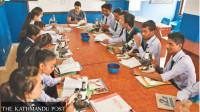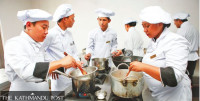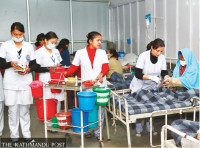Miscellaneous
At the epicentre
Barkpak lies in ruins but volunteers and locals have done a remarkable job of nudging it on the road to recovery. Now the surrounding areas need help to get going too
Dewan Rai
Every day, the women of the village (most of the men here have gone abroad to work) throng the centre, carrying dokos to carry back relief materials, often food items. The relief materials are to be distributed in the presence of the village development secretary and local representatives and security personnel—to avoid the possibility of mob chaos. Barpak’s 1,470 households have been surviving on the relief supplies that have been sent to the village over the past one month, since the earthquake flattened the village. The relief supplies are pouring in. Only last Wednesday, the United Trungram Buddhist Foun-dation, a non-profit Buddhist centre, dropped off a huge consignment of rations here. The president of the foundation, Trungram Gyaltrul Rinpoche Sherpa, himself arrived here to distribute the relief materials.
The Rinpoche—who has a doctoral degree in Indo-Tibetan Buddhist Studies from Harvard University and conducts meditation courses in Europe and the US—got involved in helping the village right after the Great Quake hit. His foundation has already distributed 30 kg sacks of rice along with a litre of vegetable oil and lentils to all the households in the village.
“We are so relieved that the people helping the village brought enough relief supplies for every household. Otherwise we would have probably had to deal with quite a bit of chaos,” says a security personnel.
According to the Rinpoche’s foundation, its long-term recovery efforts include helping people re-establish themselves, founding an orphanage for those made bereft by the earthquake and rebuilding monasteries. It has already spent Rs 4 million so far in distributing food, water, medicine and temporary shelters in earthquake-hit districts across Nepal.
“We now have enough rations to last a couple of months,” says a local, Tan Raj Ghale. “However, we cannot totally rule out the possibility of famine. We will be able to harvest corn but we lost our rice plants due to the unusual weather after the quake.” According to Tan Raj, Barpak has not had enough rainfall and the days have been unusually windy, which have together taken a toll on the paddy plants. And much of the corn fields are now occupied by people who have lost their houses.
The Great Quake, which had its epicentre here, destroyed almost 90 percent of the houses in the village. Situated at an altitude of 1,900 metres above sea level, Barpak, a popular village on the Manaslu trekking circuit, has lost much of its closely clustered stone-shingled houses, and only a few of the newly constructed cement houses are still standing.
Barpak was once considered an exemplar of rural development done right: it was self-reliant and prosperous and its villagers were known for their entrepreneurial spirit. The village used to have round-the-clock electricity and internet access. It was renowned as a home-stay village and the hospitable reputation earned by its Ghale residents used to attract flocks of tourists. The quake shook everything to the core.
Now, the villagers need to start from square one; first, they need to clear out the rubble and debris. “Removing rubble and salvaging wooden planks, beams and stone slabs have become our daily routine,” says Ash Ghale. “We have a long way to go to get back to where we were.” Bir Bahadur Ghale seems like the man with the vision to get the village back on track. An Ashoka fellow, Ghale wants to not just restore the village but also develop it as an organised settlement.
He leads a team of villagers who work on behalf of the Barpak Help Foundation, a registered entity, to support the reconstruction of the village. The foundation is supported in its efforts by the Ex-Barpaki Students’ Society, Seven Sisters, local women groups and youth groups; many of them help with fundraising and other relief and reconstruction activities.
Bir Bahadur says every household in the organised settlement already has electricity, drinking water, and sewage facilities. “And we have also realised the importance of leaving open spaces,” he says.
He is now pushing for building earthquake-resistant houses made of light materials but he also thinks the houses should incorporate the cultural aesthetics of the community.
The village is also being helped by NRN president and CEO of the Melbourne Institute of Technology Shesh Ghale, who has promised to help develop a master plan for the village.
That macro-level planning will be needed because the quake destroyed not only houses but all the schools, a museum, public mills and community centres. A 130-kilowatt power plant was also demolished by the quake. Today, with the help of the Gorkhali Foundation, a 50 Kva diesel generator has already been set up to provide power for the village.
“But time is of the essence now,” says Bir Bahadur. The monsoon is almost here, and most of the people who have been living under tarp sheets will need to be housed in permanent shelters.
Besides, people from the nearby villages, such as Ishinanda Pokhari, have to be resettled en masse. And although Barpak Village has received a lot of attention in the media, the neigbhouring villages of Mandre, Rangroong, Balfe, Jhyal Khola, Lyawe, Thali Gaun, Koje, Timsika and Algaun, which have been equally badly hit, have not received adequate relief supplies. “The situation in the neighbouring VDCs is really awful,” says Jivan Gautam, a central Committee member of the UCPN (Maoist), whose volunteers have been building a temporary learning centre in Barpak.
The team includes Dhiraj Sherpali, a CA election candidate from Dang 5, former Maoist Brigade Commander Hira Lal Tharu, former Brigade Vice-commandar Nirmal Mahara (son of Krishna Bahadur Mahara) and Jagbir Chaudhari. Gautam says that villages in Saurpani VDC, near Barpak, also need the relief workers’ attention. “There is not a single house standing there as there were no cement houses like at Barpak,” he says. That is why the UCPN (Maoist) volunteers constructed 100 shelters in Saur Pani VDC in two days before moving on to working in Barpak. With the volunteers, locals and relief organisations already setting Barpak on the course to recovery, Gautam says relief efforts need to now focus on places like Jhakriswora Village in Saurpani VDC and Samagau, Lho, Prok, Chumchet, Nubri and Chekmpar, in Himal Pariko VDCs, which still haven’t received relief supplies.




 17.12°C Kathmandu
17.12°C Kathmandu










